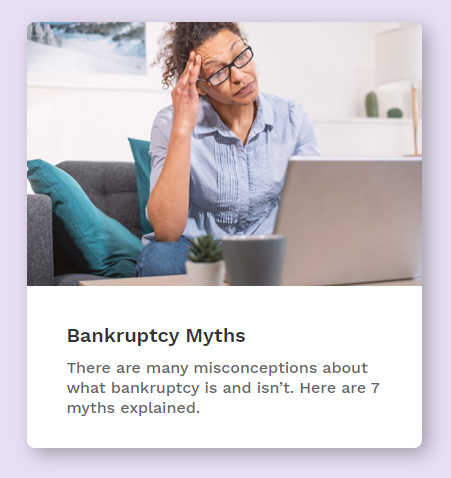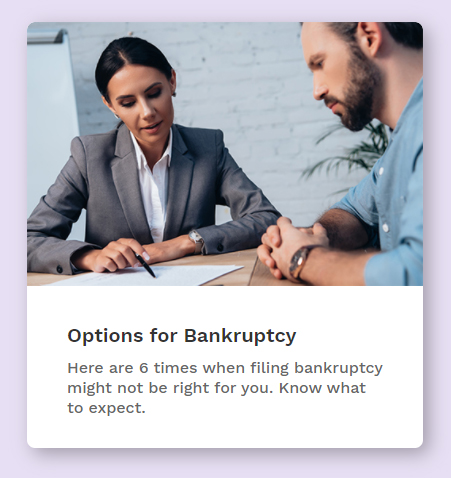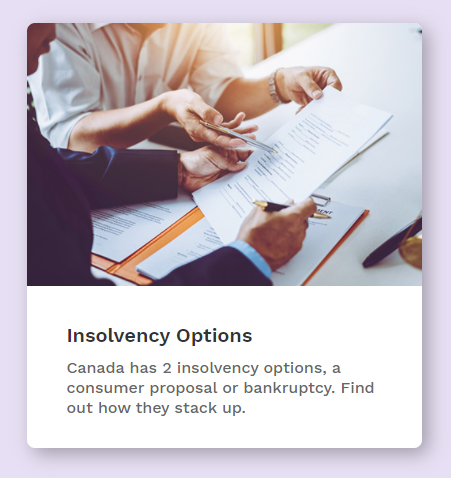Who Insolvency is For
Being stuck in debt is scary, but fortunately, there are many options for overcoming financial difficulties. When facing extreme financial challenges, people are considered “insolvent” if they no longer have the means or ability to repay their debt. Insolvency is a legal process governed by Canada’s Bankruptcy and Insolvency Act. There are 2 ways to deal with debt through insolvency: a consumer proposal or bankruptcy.
Consumer Proposal
Most people know about bankruptcy, but not as many have heard about consumer proposals. A proposal is another way to settle your debts and make payments over a period of time. It involves formally sending creditors a “proposal” to repay less than you owe, and if they agree, then you have 5 years to finish making your payments. This can provide you with some debt relief and potentially protect assets like your home. However, it also comes with costs and conditions that can’t be ignored.
Bankruptcy
Declaring bankruptcy is the first choice most people think of when facing serious financial difficulty. However, this is a big decision that will have long-term consequences for your credit and job opportunities in certain fields. A lot of people come to us believing that bankruptcy is their only option, but when we explain the other solutions available, many change their minds. Get the full picture on bankruptcy and its alternatives before making a choice that could change your life.
Avoid Unnecessary Fees
There are a number of for-profit companies that advertise insolvency – especially consumer proposals – as a quick and easy way to get rid of your debt. However, by law, only a Licensed Insolvency Trustee (LIT) can fill out and file paperwork for insolvency. Trustees are specifically licensed by the Canadian government to administer these debt relief options, and the best way to find a reputable one near you is to contact a non-profit credit counselling organization like us.
Non-profits know who the good bankruptcy trustees are. Because credit counsellors at non-profits are not paid commission, they can objectively guide you towards the best solution for your financial challenges – and it won’t cost a cent.
Avoid Unnecessary Fees
There are a number of for-profit companies that advertise insolvency – especially consumer proposals – as a quick and easy way to get rid of your debt. However, by law, only a Licensed Insolvency Trustee (LIT) can fill out and file paperwork for insolvency. Trustees are specifically licensed by the Canadian government to administer these debt relief options, and the best way to find a reputable one near you is to contact a non-profit credit counselling organization like us.
Non-profits know who the good bankruptcy trustees are. Because credit counsellors at non-profits are not paid commission, they can objectively guide you towards the best solution for your financial challenges – and it won’t cost a cent.
If either a consumer proposal or bankruptcy appears to be your best option, they will refer you to a reputable, licensed trustee, who will then help you legally file for insolvency. You can also check if a trustee is licensed by referencing the Government of Canada’s Licensed Insolvency Trustee directory.
Unfortunately, some debt relief companies charge people thousands in fees only to then refer them to a trustee. The trustee then charges thousands more in legitimate consumer proposal or bankruptcy fees that are set by the government. Don’t pay more than you have to. When in doubt, ask for advice from a non-profit credit counselling organization. They are there to help guide you through these challenges – not make money off your difficulties.
If either a consumer proposal or bankruptcy appears to be your best option, they will refer you to a reputable, licensed trustee, who will then help you legally file for insolvency. You can also check if a trustee is licensed by referencing the Government of Canada’s Licensed Insolvency Trustee directory.
Unfortunately, some debt relief companies charge people thousands in fees only to then refer them to a trustee. The trustee then charges thousands more in legitimate consumer proposal or bankruptcy fees that are set by the government. Don’t pay more than you have to. When in doubt, ask for advice from a non-profit credit counselling organization. They are there to help guide you through these challenges – not make money off your difficulties.
Think your situation is really bad?
You still have options.
Between financial difficulty and bankruptcy are many options. One of our certified credit counsellors can help you explore all of them and see if you need to get a consumer proposal, file for bankruptcy, or if there’s a better option. They can answer your questions honestly and objectively. Speaking with one of our counsellors is always free, confidential and without obligation.
Bankruptcy vs. Consumer Proposal
Whether you file for bankruptcy or a consumer proposal depends on a number of factors including your financial situation, goals, and possibly even your job. Both insolvency options will typically allow you to repay only a portion of your unsecured debts and both have a variety of fees attached to them. Both will also create a permanent, searchable public record, which will show that you chose to deal with your debts through the insolvency process. With these similarities out of the way, here are some differences to be aware of:
- You technically don’t need to give up assets like your house and car when filing a consumer proposal – a consequence many associate with bankruptcy. However, in some cases your equity in these assets may be added to the cost of your consumer proposal. So you can end up paying extra to keep your own stuff.
- While first-time bankruptcies can take between 9 – 21 months and consumer proposals can take close to 5 years, it’s normal to see a proposal hurt someone’s credit for 6 years and bankruptcy for 7 – 9 years.
- With a consumer proposal, creditors vote on whether to accept the proposal your trustee submits to them. If these negotiations fail or if you miss more than 3 payments, you may be left with bankruptcy as your only option.
Bankruptcy vs. Consumer Proposal
Whether you file for bankruptcy or a consumer proposal depends on a number of factors including your financial situation, goals, and possibly even your job. Both insolvency options will typically allow you to repay only a portion of your unsecured debts and both have a variety of fees attached to them. Both will also create a permanent, searchable public record, which will show that you chose to deal with your debts through the insolvency process. With these similarities out of the way, here are some differences to be aware of:
- You technically don’t need to give up assets like your house and car when filing a consumer proposal – a consequence many associate with bankruptcy. However, in some cases your equity in these assets may be added to the cost of your consumer proposal. So you can end up paying extra to keep your own stuff.
- While first-time bankruptcies can take between 9 – 21 months and consumer proposals can take close to 5 years, it’s normal to see a proposal hurt someone’s credit for 6 years and bankruptcy for 7 – 9 years.
- With a consumer proposal, creditors vote on whether to accept the proposal your trustee submits to them. If these negotiations fail or if you miss more than 3 payments, you may be left with bankruptcy as your only option.
The bottom line is that filing for bankruptcy or a consumer proposal is a serious choice with long-lasting consequences. Even though insolvency can be the right choice for some people in certain situations, it should be a last resort for when you’ve exhausted all other options for debt relief. If you’re not sure what you should do or what your options are, contact us and one of our credit counsellors will be happy to review your situation with you.
The bottom line is that filing for bankruptcy or a consumer proposal is a serious choice with long-lasting consequences. Even though insolvency can be the right choice for some people in certain situations, it should be a last resort for when you’ve exhausted all other options for debt relief. If you’re not sure what you should do or what your options are, contact us and one of our credit counsellors will be happy to review your situation with you.
Debt Management Program
When considering all your options, one alternative to bankruptcy or a consumer proposal is a Debt Management Program (DMP). This is offered by non-profit credit counselling organizations like us. We negotiate with creditors to consolidate your unsecured debt payments into one monthly payment that fits your budget.
Debt Management Program
When considering all your options, one alternative to bankruptcy or a consumer proposal is a Debt Management Program (DMP). This is offered by non-profit credit counselling organizations like us. We negotiate with creditors to consolidate your unsecured debt payments into one monthly payment that fits your budget.
The interest rate on your debts going forward is often significantly reduced or decreased to zero. One of our credit counsellors will also help you stay on track to becoming debt free and even help you rebuild your credit afterwards.
For many people, a DMP has clear benefits over bankruptcy or a consumer proposal. For example, all debts included in the DMP are erased from your credit report 2 years after you finish the program or 6 years after you start – whichever comes first (an average DMP is paid off in less than 3 years). Compare that to waiting 6 – 7 years after completing a bankruptcy or a year after completing a typical 5 year consumer proposal. A DMP is also kept completely private between you and your creditors and no permanent or public records are ever created. So your personal financial matters always remain private, and your job and future career options are never impacted.

We would recommend your organization to anyone
Kristy & Dan
Get the clarity you need.
Speak with a non-profit credit counsellor.
Between financial difficulty and bankruptcy are many options. At a time like this, it can be helpful to sit down with a knowledgeable credit counsellor who can talk through all your options and make a plan to resolve your difficulties. Once you can see your way out, you can regain your peace of mind and move forward with confidence.
Related Topics

Bankruptcy Myths
There are many misconceptions about what bankruptcy is and isn’t. Here are 7 myths explained.

Options for Bankruptcy
Here are 6 times when filing bankruptcy might not be right for you. Know what to expect.

Insolvency Options
Canada has 2 insolvency options, a consumer proposal or bankruptcy. Find out how they stack up.









